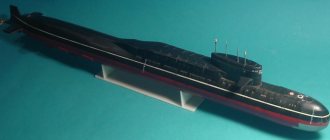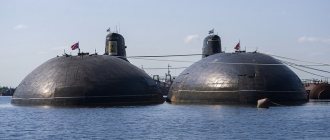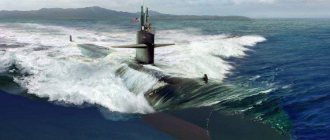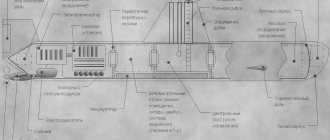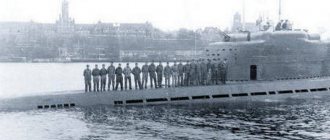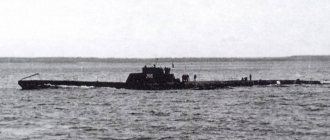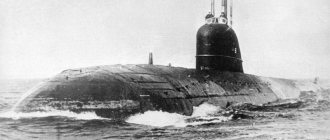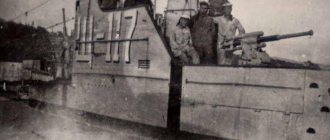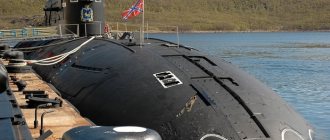Ohio-class nuclear-powered ballistic missile submarines (SSBNs)
Ohio-class submarines are currently the only type of strategic missile carrier in the US fleet. Ohio-class nuclear-powered ballistic missile submarines (SSBNs) were commissioned from 1981 to 1997. A total of 18 submarines were built. According to the project, each of these boats carries on board 24 intercontinental three-stage solid-fuel Trident ballistic missiles equipped with multiple warheads with individual guidance. On April 10, 1976, at the Electric Boat shipyard, construction began on a new nuclear-powered strategic submarine for the American fleet - SSBN 726 OHIO, which became the lead in a large series of similar SSBNs that were developed in accordance with the Trident program. Development and research work on the project of a new strategic missile carrier was carried out in America from October 26, 1972, and the order for the construction of the lead boat of the series was issued on July 25, 1974. Currently, all 18 boats built under this project remain in the American fleet. 17 boats were named after US states, and one boat, SSBN-730 Henry M. Jackson, was named after Senator Henry Jackson.
The United States modernized two bases specifically for the deployment of new submarines. One is on the Pacific coast - Bangor, today it is Naval Base Kitsap (formed in 2004 by merging the Bangor submarine base and Naval Base Bremerton) in Washington state, the second on the Atlantic coast is Naval Base Kings Bay in Georgia. Each of these two bases is designed to support 10 SSBNs. The necessary equipment was installed at the bases for receiving and unloading ammunition from boats, routine repairs and maintenance of submarines. All conditions have been created to ensure rest for personnel. At each base, training centers were built to train personnel. They could train up to 25 thousand people every year. Special simulators installed at the centers made it possible to practice submarine control processes in a variety of conditions, including torpedo and missile firing.
Ohio-class nuclear submarines are third generation submarines. As part of the work to create third-generation submarines, the United States was able to achieve maximum unification of its submarine forces, reducing the number of classes of submarines to two: strategic nuclear submarines and multi-purpose nuclear submarines (one boat project in each class). The Ohio-class strategic missile carriers had a traditional single-hull design for American nuclear submarines, differing from multi-purpose boats in having a fairly well-developed superstructure. When creating boats of this generation, close attention was paid to reducing the noise of submarines and improving their radio-electronic, especially sonar, weapons. A special feature of the reactors of the third generation nuclear submarines is that their service life was increased by 2 times compared to the reactors of the previous generation submarines. The reactors installed on the new boats could continuously operate at full power for 9-11 years (for strategists) or 13 years (for multi-purpose nuclear submarines). Previous reactors could not operate for more than 6-7 years. And taking into account real operating modes, which were much more gentle, third-generation nuclear submarines could serve without recharging the reactor core for up to 30 years, and in the case of one recharging - 42-44 years.
To estimate the size of the Ohio-class strategic missile carriers, it is enough to say that their hull length is 170 meters, which is practically 1.5 football fields. At the same time, these boats are considered one of the quietest in the world. However, what made them unique was not their size and noiselessness, but the composition of the nuclear weapons placed on board - 24 ballistic missiles. Until now, not a single submarine in the world can boast of having such an impressive arsenal (Russian fourth-generation Project 955 Borei nuclear submarines carry 16 R-30 Bulava ballistic missile launchers on board).
The first 8 Ohio-class nuclear submarines were armed with Trident I C4 ballistic missiles, subsequent boats received Trident II D5 missiles. Later, during the planned overhaul of submarines, 4 boats of the first series were re-equipped with Trident II D5 ICBMs, and another 4 boats were converted into carriers of Tomahawk cruise missiles.
The power plant of these SSBNs was built on the basis of the eighth generation S8G reactor. In normal operation, two turbines produce 30,000 hp. With. The shaft with the propeller was rotated through the gearbox, providing the submarine with an underwater speed of 20-25 knots. However, the highlight of boats of this type was the low-noise operating mode, when the circulation pumps of the primary circuit of the reactor stopped and it switched to natural circulation. The turbines and gearbox are stopped and separated from the shaft using a special coupling. After this, only two turbogenerators with a power of 4000 kW each remained in operation; the electricity they generated, passing through a rectifier converter, was supplied to the propeller electric motor, which rotated the shaft. In this mode, the boat developed a speed sufficient for silent patrolling. The same scheme for constructing a power plant is used on fourth-generation nuclear submarines.
Description of the design of Ohio-type boats
Ohio-type boats have a hull of mixed design: the submarine’s durable hull has a cylindrical shape with ends in the form of a truncated cone, it is complemented by streamlined ends in which the spherical antenna of the sonar, ballast tanks and the propeller shaft were located. The upper part of the boat's robust hull was covered with a lightweight, permeable, streamlined superstructure that covers the missile silos, as well as various auxiliary equipment at the stern and a flexible towed sonar antenna located at the stern end. Due to the relatively small area of the light hull, the submarine is considered a single-hull. According to American experts, this design of SSBNs creates less hydrodynamic noise and makes it possible to achieve the highest possible low-noise speed in comparison with double-hulled submarines. The hull of the boat is divided into compartments by flat bulkheads, each compartment is divided into several decks. Loading hatches were provided in the bow, missile and stern compartments. The cabin of the boat is shifted to the bow, horizontal wing-shaped rudders are installed on it, in the stern the tail of the boat is cross-shaped, and vertical faceplates are mounted on the horizontal rudders.
The submarine's robust hull was welded from sections (shells) of conical, cylindrical and elliptical shape with a thickness of 75 mm. The material used was high-strength steel grade HY-80/100, which has a yield strength of 56-84 kgf/mm. To increase the strength of the hull, the boat was provided with the installation of ring frames, which are spaced along the entire length of the hull. The boat's hull also received a special anti-corrosion coating.
The basis of the boat's power plant is a nuclear reactor - a double-circuit pressurized water reactor (PWR) type S8G, which was designed by General Electric engineers. It consists of a standard set of parts for reactors of this type: a reactor vessel, a core, a neutron reflector, control and protection rods. The steam turbine power plant includes two turbines with a capacity of 30,000 hp each. each, gearbox, condenser, circulation pump and steam lines. Both steam turbine units operate on the same shaft, while the high speed of rotation of the turbines is reduced to 100 rpm using a gearbox, after which it is transmitted to the propeller shaft using a clutch, which drives a seven-blade propeller with a diameter of 8 meters. The propeller has beveled crescent-shaped blades with a reduced rotation speed, which reduces noise at patrol speed. There are also two low-speed multi-pole turbogenerators on board, each with a power of 4 mW; they generate electricity with a voltage of 450 V and a frequency of 60 Hz, which, using an AC-to-DC converter, provides power to the propeller electric motor (in this mode of operation, steam turbine units do not rotate the propeller).
The main armament of the Ohio-class SSBNs are intercontinental ballistic missiles located in 24 vertical silos, which are located in two longitudinal rows immediately behind the retractable device fence. The ICBM shaft is a steel cylinder that is rigidly fixed to the submarine's hull. In order to be able to install Trident II missiles on board, the missile silo was initially enlarged compared to the boats of the previous project; its length is 14.8 meters and its diameter is 2.4 meters. The shaft is closed from above with a lid equipped with a hydraulic drive; it ensures sealing of the shaft and is designed for the same level of pressure as the submarine’s durable hull. On the cover there are 4 control and adjustment hatches, which are intended for routine inspections. A special locking mechanism is designed to provide protection against unauthorized access and controls the opening of technological hatches and the lid itself.
The Trident ICBM can be launched at 15-20 second intervals from a diving depth of up to 30 meters, at a boat speed of approximately 5 knots and sea state up to 6 points. All 24 missiles can be fired in one salvo, while test launches of the entire boat's ammunition load in one salvo have never been carried out in the United States. The rocket moves uncontrollably in the water; after it reaches the surface, according to the acceleration sensor data, the first stage engine is activated. In normal mode, the engine is turned on at an altitude of about 10-30 meters above the sea surface.
Trident II D-5 rocket launch
Trident II D-5 missiles can be equipped with two types of warheads - W88 with a yield of 475 kt each and W76 with a yield of 100 kt each. At maximum load, one missile can carry 8 W88 warheads or 14 W76 warheads, providing a maximum flight range of 7360 km. The use of special astro-correction equipment on rockets, together with an increase in the efficiency of the navigation system, made it possible to achieve a circular probable deviation for W88 blocks of 90-120 meters. When hitting enemy missile silos, the so-called “2 by 1” method can be used, when two warheads from different missiles are simultaneously aimed at one ICBM silo. Moreover, when using W88 units with a power of 475 kt, the probability of hitting a target is 0.95. When using W76 blocks, the probability of hitting a target with the same “2 by 1” method is already 0.84. In order to achieve the maximum flight range of ballistic missiles, 8 W76 warheads or 6 W88 warheads are usually installed on board them.
For self-defense, each boat was equipped with 4 TAs of 533 mm caliber. These torpedo tubes are located in the bow of the submarine slightly at an angle to the center plane. The boat's ammunition load includes 10 Mk-48 torpedoes, which can be used against surface ships and submarines of a potential enemy.
As part of the submarine modernization under the A-RCI (Acoustic Rapid COTS Insertion) program, all Ohio-class submarines were upgraded to the AN/BQQ-10 variant. Instead of 4 GUS, a common COTS (commercial-off-the-shelf) type station was used, which has an open architecture. This solution makes it possible to simplify the process of upgrading the entire system in the future. The Alaska boat was the first to undergo modernization in the fall of 2000. The new system, among other things, has the ability to conduct “hydroacoustic mapping” (PUMA - Precision Underwater Mapping and Navigation). This allows the SSBN to create a high-resolution hydrographic map and share it with other ships. The resolution of the equipment installed on board makes it possible to distinguish even small objects such as mines.
A special AN/WLR-10 station is used to alert the crew about acoustic radiation. Together with it, at the moment when the boat is on the surface, the AN/WLR-8(V)5 radar warning station is used, operating in the range of 0.5-18 GHz. The submarine also received 8 Mk2 launchers designed for acoustic jamming and an AN/WLY-1 hydroacoustic countermeasures station. The main purpose of this station is to automatically detect, classify and subsequently track attacking torpedoes and send a signal to use hydroacoustic countermeasures.
During 2002-2008, the first 4 Ohio class boats (SSGN 726 Ohio, SSGN 727 Michigan, SSGN 728 Florida, SSGN 729 Georgia), which were armed with Trident I ICBMs, were converted into SSGNs. As a result of the modernization, each of the boats can carry on board up to 154 Tomahawk cruise missiles. At the same time, 22 of the 24 existing silos were modernized for the vertical launch of cruise missiles. Each such mine can accommodate 7 Tomahawk missile launchers. At the same time, the two shafts closest to the wheelhouse were equipped with airlock chambers. ASDS mini-submarines or DDS modules designed to allow combat swimmers to exit while the nuclear submarine is submerged can be docked to these cameras. These devices can be installed on the boat either together or separately, with a total number of no more than two. At the same time, due to their installation, silos with cruise missiles are partially blocked. For example, each ASDS blocks three mines at once, and the shorter DDS module blocks two. As part of a special operations unit (SEALs or Marines), the boat can additionally transport up to 66 people, and in the case of a short-term operation, the number of paratroopers on board the boat can be increased to 102 people.
Currently, Ohio-class SSBNs continue to hold the lead in the number of missile silos located on board - 24 and are still considered one of the most advanced in their class. According to experts, among the built strategic missile carriers, only French boats of the Triumphant type can compete with these boats in terms of noise level. The high accuracy of the Trident II ICBM makes it possible to hit not only land-based ICBMs, but also the entire range of high-strength targets such as in-depth command posts and silo launchers, and the long launch range (11,300 km) allows the Ohio-class SSBN to carry out combat duty in the Atlantic and Pacific ocean in the zone of dominance of its own naval forces, which provides the boats with fairly high combat stability. The combination of low maintenance costs and high efficiency of these submarines armed with Trident II ICBMs has led to the fact that naval strategic forces currently occupy a leading position in the US nuclear triad. The last Ohio class boat is scheduled to be decommissioned in 2040.
Tactical and technical characteristics of the Ohio-class SSBN: Overall dimensions: length - 170.7 m, width - 12.8 m, draft - 11.1 m. Displacement - 16,746 tons (underwater), 18,750 tons (surface). Submarine speed is 25 knots. Surface speed is 17 knots. Immersion depth - 365 m (working), 550 m (maximum). Power plant: nuclear, pressurized water reactor type GE PWR S8G, two 30,000 hp turbines, two 4 MW turbogenerators, 1.4 MW diesel generator. Missile armament: 24 Trident II D-5 ICBMs. Torpedo armament: 4 TA 533 mm caliber, 10 Mk-48 torpedoes. Crew - 155 people (140 sailors and 15 officers).
Kings Bay base for servicing Ohio shooting range SSBNs assigned to the US Navy's Atlantic Fleet
Sources of information: https://armyman.info/flot/podvodnye-lodki/18956-podvodnye-lodki-tipa-ogayo.html https://bastion-karpenko.ru/ohio-ssbn-726 https://korabley.net /news/atomnye_podvodnye_lodki_sravnenie_dvukh_proektov/2012-04-16-1167 https://xpda.com/kingsbay (photo) Based on materials from open sources.
K-329 "Belgorod"
Length - 184 meters
As we have already said, the famous Akula-class submarine may be the largest in the world in terms of displacement, but Belgorod takes first place in length - 184 meters. This is equivalent to the height of a 50-story skyscraper or 20 school buses lined up in a row. This nuclear death machine was assembled at a shipyard and launched in 2022. Belgorod also carries the unique deep-sea submarine AS-12 (Losharik).
Both submarines are nearly impenetrable, but while the Losharik will be used for covert missions and underwater espionage, the Belgorod can carry one of the largest and deadliest torpedoes ever made, the Poseidon. This 2-megaton torpedo with a nuclear warhead is rumored to be capable of traveling thousands of kilometers.
SLBM Lockheed UGM-73A Poseidon C3
By 1964, two promising submarine-launched ballistic missile designs were submitted for consideration. One was subsequently implemented as the Lockheed UGM-73A Poseidon SZ submarine-launched ballistic missile, which could use the launch silos of existing US Navy nuclear missile submarines. Ultimately, 31 of the original 41 nuclear-powered missile submarines built were upgraded to use Poseidon missiles. Some were later re-upgraded to accept missiles...
Read more

